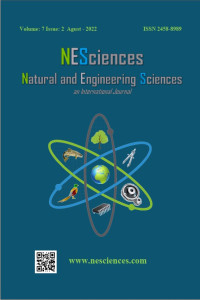Abstract
The ethanol extracts obtained from the leaves of Stachys sylvatica L. (Lamiaceae) were evaluated for their antibacterial activity against some human eye pathogens by disc diffusion method against hospital isolates of Bacillus cereus, Pseudomonas aeruginosa, Klebsiella pneumoniae, Staphylococcus capitis, Staphylococcus aureus, Staphylococcus epidermidis, Moraxella nonliquefaciens and Cutibacterium acnes. Besides, Penicillin, Ampicillin and Tobramycin as antibacterial antibiotics were used as a positive reference standard to determine the sensitivity of the isolates. The extracts showed a potential antibacterial effect against Staphylococcus capitis, Moraxella nonliquefaciens and Cutibacterium acnes, with inhibition zones of 22.4 mm, 21.6 mm and 20.2 mm, respectively. The extracts also exhibited a moderate effect against the other bacterial isolates. The plant may be useful in the treatment of eye infections.
References
- Altundag, E. & Ozturk, M. (2011). Ethnomedicinal studies on the plant resources of east Anatolia, Turkey. Procedia Social and Behavioral Sciences, 19: 756–777.
- Bhattacharjee, R. (1982). Stachys L. in: Flora of Turkey and East Aegean Islands, vol 7. Editor: Davis PH. Edinburg University Press. Edinburg.
- Collins, C.M., Lyne, P.M. and Grange, J.M. (1995). Microbiological Methods. London: Butterworths and Co. Ltd., p. 450.
- Cornaro, L., La Rocco, A., Terrizzana, L., Dente, F. and Mariotti, M.G. (2014). Ethnobotanical and phytochemical knowledge in the North-Western Lingurian Alps. Journal of Ethnopharmacology, 155(1), 453-484. https://doi.org/10.1016/j.jep.2014.05.046.
- Davis, P.H., Mill, R.R. and Tan, K. (1988). Flora of Turkey and the East Aegean Islands, vol 10. Edinburg University Press. Edinburg, 1988, pp. 204-216.
- Dimitrova-Duyulgerova, I., Merdzhanov, P., Todorov, K., Seymenska, D., Stoyanov, P., Mladenov, R. and Stoyanova, A. (2015). Essential oils composition of Betonica officinalis L. and Stachys sylvatica L. (Lamiaceae) from Bulgaria. Comptes Rendus de L’Académie Bulgare des Sciences, 68(8), 991-998.
- Duman, H. (2000). Stachys L. in: Flora of Turkey and the East Aegean Islands, vol 11. Editors: Guner, A, Ozhatay, N, Ekim, T, Baser, KHC. Edinburg University Press. Edinburg, 2000, pp. 204-206.
- Grujic-Jovanovic, S., Skaltsa, H.D., Marin, P. and Sokovic, M. (2004). Composition and antibacterial activity of the essential oil of six Stachys species from Serbia. Flavour and Fragrance Journal, 19(2), 139-144. https://doi.org/10.1002/ffj.1275.
- Manganelli, R.U., Camangi, F. and Tomei, P.E. (2001). Curing animals with plants: Traditional usage in Tuscany (Italy). Journal of Ethnopharmacology, 78, 171-191. https://doi.org/10.1016/S0378-8741(01)00341-5.
- Mukemre, M., Behcet, L. and Cakilcioglu, U. (2015). Ethnobotanical study on medicinal plants in villages of Catak (Van- Turkey). Journal of Ethnopharmacology, 166: 361- 374. https://doi.org/10.1016/j.jep.2015.03.040.
- Polat, R., Cakilcioglu, U. Kaltalioglu, K. Ulusan, M.D. and Turkmen, Z. (2015). Ethnobotanical study on medicinal plants in espiye and its surrounding (Giresun- Turkey). Journal of Ethnopharmacology, 163: 1-11. https://doi.org/10.1016/j.jep.2015.01.008.
- Renda, G., Bektas, N.Y., Korkmaz, B., Celik, G., Sevgi, S. and Yayli, N. (2017). Volatile constituents of three Stachys L. species from Turkey. Marmara Pharmaceutical Journal, 21(2), 278-285. https://doi.org/10.12991/marupj.300353.
- Trillini, B., Pellegrino, R. and Bini, L.M. (2004). Essential oil composition of Stachys sylvatica L. from Italy. Flavour and Fragrance Journal, 19(4), 330-332. https://doi.org/10.1002/ffj.1308.
- Viegi, L., Pieroni, A. Guarrera, P.M. and Vangelisti, R. (2003). A review of plants used in folk veterinary medicine in Italy as basis for a databank. Journal of Ethnopharmacology, 89(2-3), 221-224. https://doi.org/10.1016/j.jep.2003.08.003.
Abstract
References
- Altundag, E. & Ozturk, M. (2011). Ethnomedicinal studies on the plant resources of east Anatolia, Turkey. Procedia Social and Behavioral Sciences, 19: 756–777.
- Bhattacharjee, R. (1982). Stachys L. in: Flora of Turkey and East Aegean Islands, vol 7. Editor: Davis PH. Edinburg University Press. Edinburg.
- Collins, C.M., Lyne, P.M. and Grange, J.M. (1995). Microbiological Methods. London: Butterworths and Co. Ltd., p. 450.
- Cornaro, L., La Rocco, A., Terrizzana, L., Dente, F. and Mariotti, M.G. (2014). Ethnobotanical and phytochemical knowledge in the North-Western Lingurian Alps. Journal of Ethnopharmacology, 155(1), 453-484. https://doi.org/10.1016/j.jep.2014.05.046.
- Davis, P.H., Mill, R.R. and Tan, K. (1988). Flora of Turkey and the East Aegean Islands, vol 10. Edinburg University Press. Edinburg, 1988, pp. 204-216.
- Dimitrova-Duyulgerova, I., Merdzhanov, P., Todorov, K., Seymenska, D., Stoyanov, P., Mladenov, R. and Stoyanova, A. (2015). Essential oils composition of Betonica officinalis L. and Stachys sylvatica L. (Lamiaceae) from Bulgaria. Comptes Rendus de L’Académie Bulgare des Sciences, 68(8), 991-998.
- Duman, H. (2000). Stachys L. in: Flora of Turkey and the East Aegean Islands, vol 11. Editors: Guner, A, Ozhatay, N, Ekim, T, Baser, KHC. Edinburg University Press. Edinburg, 2000, pp. 204-206.
- Grujic-Jovanovic, S., Skaltsa, H.D., Marin, P. and Sokovic, M. (2004). Composition and antibacterial activity of the essential oil of six Stachys species from Serbia. Flavour and Fragrance Journal, 19(2), 139-144. https://doi.org/10.1002/ffj.1275.
- Manganelli, R.U., Camangi, F. and Tomei, P.E. (2001). Curing animals with plants: Traditional usage in Tuscany (Italy). Journal of Ethnopharmacology, 78, 171-191. https://doi.org/10.1016/S0378-8741(01)00341-5.
- Mukemre, M., Behcet, L. and Cakilcioglu, U. (2015). Ethnobotanical study on medicinal plants in villages of Catak (Van- Turkey). Journal of Ethnopharmacology, 166: 361- 374. https://doi.org/10.1016/j.jep.2015.03.040.
- Polat, R., Cakilcioglu, U. Kaltalioglu, K. Ulusan, M.D. and Turkmen, Z. (2015). Ethnobotanical study on medicinal plants in espiye and its surrounding (Giresun- Turkey). Journal of Ethnopharmacology, 163: 1-11. https://doi.org/10.1016/j.jep.2015.01.008.
- Renda, G., Bektas, N.Y., Korkmaz, B., Celik, G., Sevgi, S. and Yayli, N. (2017). Volatile constituents of three Stachys L. species from Turkey. Marmara Pharmaceutical Journal, 21(2), 278-285. https://doi.org/10.12991/marupj.300353.
- Trillini, B., Pellegrino, R. and Bini, L.M. (2004). Essential oil composition of Stachys sylvatica L. from Italy. Flavour and Fragrance Journal, 19(4), 330-332. https://doi.org/10.1002/ffj.1308.
- Viegi, L., Pieroni, A. Guarrera, P.M. and Vangelisti, R. (2003). A review of plants used in folk veterinary medicine in Italy as basis for a databank. Journal of Ethnopharmacology, 89(2-3), 221-224. https://doi.org/10.1016/j.jep.2003.08.003.
Details
| Primary Language | English |
|---|---|
| Subjects | Clinical Sciences |
| Journal Section | Articles |
| Authors | |
| Publication Date | August 8, 2022 |
| Submission Date | March 3, 2022 |
| Published in Issue | Year 2022 Volume: 7 Issue: 2 |
We welcome all your submissions
All published work is licensed under a Creative Commons Attribution 4.0 International License Link . Creative Commons License
NESciences.com © 2015


